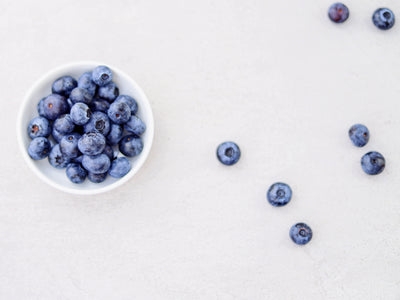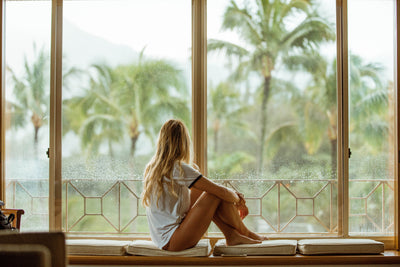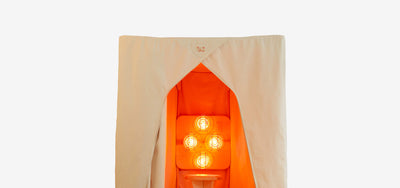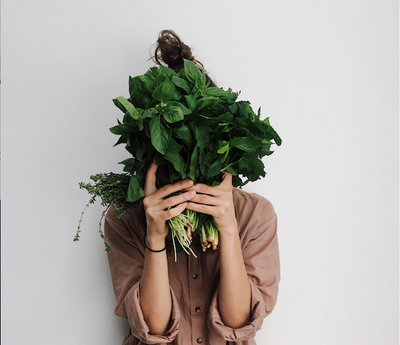5 Natural, Non-Toxic Materials to Breathe New Life into Your Interiors
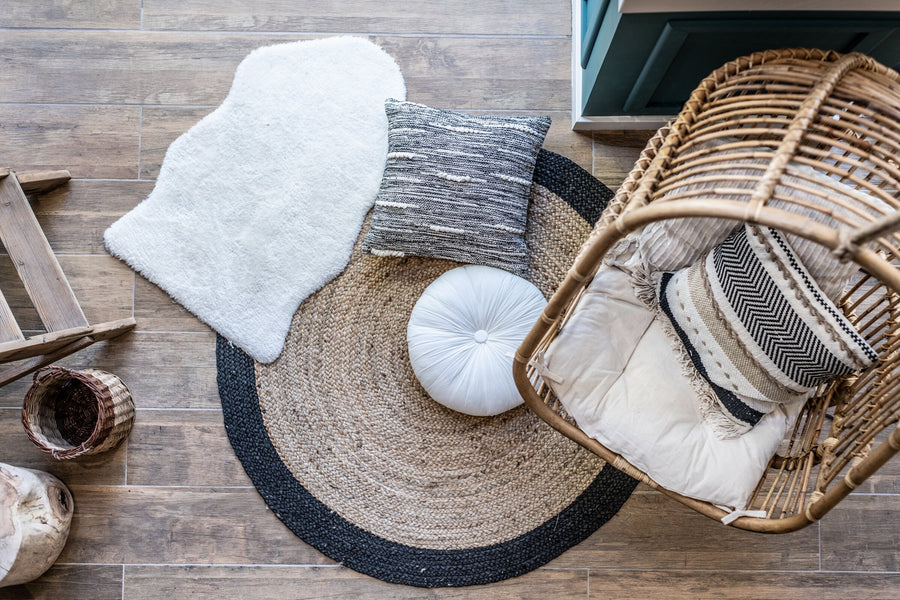
With the biophilic design trend blossoming in interiors across the globe, pure and authentic materials that feel attuned to nature are being used to console and comfort, repair and recharge.
From the soothing effects of water and plants to the de-stressing properties of wood and the biological boosts of clean air and warm light, biophilia is said to be the 'western, contemporary version of the eastern Feng shui',[1] and it’s the perfect balm to the chaos 2020 has wrought. Increasingly, the dream home is one where organic materials, shown-off in simple, sustainably-made forms, reinforce a feeling of purity and peace.
The potential health benefits of being inside conscious, considered environments that bring us closer to nature are significant, ranging from reduced heart rate variability to decreased blood pressure and lower stress levels. One study by Harvard University showed that cognitive abilities increase by 61%[2] in green-certified buildings, whilst another[3] found that workers in green buildings experienced better sleep quality, fewer headaches and less nausea.
With growing awareness of the dangers of toxins in the home – from polluted air to chemically-treated textiles and harmful varnishes and glues – not to mention their damaging impact on the plant, people are demanding more from their interiors. Not only do they need to look good, but they need to be as non-toxic and close to their natural state as possible. Read on to discover five natural materials to breathe new life into your space and help you forge a more meaningful connection to the outdoors.
1. Clay plaster

Clay plaster is arguably the most sustainable and healthy wall finish you will find. Made using abundant and recyclable natural resources, it is free from toxins, chemicals and odours. And as if that wasn't enough, clay plaster is naturally fire-retardant, sound-absorbing, humidity-regulating and thermally efficient, too.
Ultra-breathable, clay plasters are hygroscopic, meaning they attract and absorb moisture from the air. By regulating[4] relative interior humidity between 40% and 70%, clay plaster improves air quality, minimising moulds and damp. When applied to bathroom walls, clay plaster will absorb moisture caused by steamy showers or soaks in the tub, working as a natural extractor fan to remove condensation. Research[5] even suggests that clay wall coatings can passively remove ozone, a respiratory irritant with toxic by-products such as formaldehyde, from buildings.
Timelessly beautiful, clay plasters create elemental textures and warming tones that can provide sumptuously smooth or rustic appeal depending on the desired effect. With their relaxed charm and ability to softly diffuse light, clay-clad interiors cocoon their inhabitants in calm. Clay plaster is easy to apply, too – requiring the same standard tools and methods as any other plaster.
Staying true to our West Country roots, we love Cornish brand Clayworks, who create clay plasters composed of 100% natural materials. Using a unique blend of unfired clays mixed with minerals and pigments, they offer a variety of finishes from velvety to coarse in a wide range of mineral colours.
2. Jute

Affordable, versatile and 100% biodegradable, jute should be high on any eco-friendly interior checklist. A natural fibre derived from plants, jute can be grown year-round without the use of pesticides or fertilisers and is rapidly renewable. Declared passé when shiny new synthetic materials like polythene and plastic hit the scene in the 1980s, jute has staged a spectacular comeback in recent years. Home-owners have warmed to its rustic charm and sustainable attributes, liking the pared-back bohemia it can bring to a space.
Resilient, neutral and durable, jute makes an ideal material for a rug. Unlike carpet, which can trap allergens and off-gas chemicals, untreated jute is toxin-free and won’t trigger any sensitivities. There’s just one downside: the dried-leaf fibres of a jute rug can be tricky to clean. Avoid placing them in kitchens or under dining tables where jute-sabotaging spillages could occur.
To enhance the rich organic colour and texture of a woven jute rug, layer it on a wooden floor, and accessorise with woven house plant holders and rattan touches for a warm and earthy look.
3. Cork

A staple of wholesome 1970’s interior design, cork is breaking free from its retro confines to become a conscious contemporary choice thanks to its incredible sustainability, durability and versatility. Even the modern art world has embraced it, with a 5,000-square metre cork floor laid as part of a 2017 installation at the Tate Modern and architects Herzog and de Meuron choosing to line the Serpentine Gallery’s basement with it.
Entirely unprocessed, natural and toxin-free, cork comes from the cork oak tree. Super-fast growing, it is the only tree that can have its bark removed without harming it. Multiple harvests can be made from one tree during its (usually approximately 200-year) lifetime – making cork an extremely sustainable option. With more carbon dioxide captured by cork trees than is used to make cork tiles, this material is not only carbon-neutral but carbon-negative, as well as being biodegradable.
Naturally waterproof, antimicrobial and resistant to mould and mildew, cork makes an excellent choice for flooring, mats and even wall finishes – especially in humid areas like kitchens and bathrooms. Cork installation is quick and affordable. Cork tiles can usually be laid on top of existing flooring or walls, slotting into place without the need for any noxious glues or varnishes, external cladding or internal plastering. It’s brilliant at absorbing sound and keeping the heat in, too, as well as bringing organic texture to a space.
Not so keen on the traditional orangey tone? Fear not, as these days cork comes in more neutral shades of off-white, charcoal and soft grey. Even the warmer-hued varieties will gradually become gently sun-bleached, turning to a tasteful silvery-grey over time.
4. Linen

To create an authentic, pure, lived-in yet refined interior, incorporate linen.
Cultivated from the flax plant, linen is one of the oldest and most environmentally-friendly fibres in the world. Flax is a renewable resource and can be grown without irrigation, using only rainwater. Flax is also an incredibly resilient plant that consumes far less water than cotton, as well as having a longer lifespan. It can thrive on poor-quality earth and may even help[6] improve the condition of previously polluted soils.
The eco-credentials of this wonder-fibre don’t end there. Linen requires far less use of pesticides and artificial fertilisers than cotton, and when left untreated (not chemically dyed), it is fully biodegradable.
With its pared-back, beachy minimalism, linen works well used on soft furnishings, from sofa covers to cushions. Linen curtains create an airy feel, allowing light to filter softly through. Linen is also much-loved as a bedding material for its ability to keep you exquisitely cool even on the stuffiest of nights.
Opt for untreated linens coloured using natural dyes, or work with the beauty of the natural hues of the flax plant, which range from shades of ivory to sand and pale grey.
Why not source your own linen and have it made up into a design of your choice by a local seamstress? Green Fibres has been making and selling organic textiles for over 15 years and offers a wide range of natural fabrics available for delivery to your door.
5. Natural wood

Durable, timeless and with an inimitable pure beauty, wood should play a starring role in any natural interior.
Spaces crafted from wood feel restorative and calming, with studies repeatedly showing their health benefits. For example, children who learned[7] in a timber classroom furnished with solid wood displayed measurably lower heart rates and stress levels. At the other end of the age spectrum, elderly care home residents showed[8] a marked increase in social interactions and activity when in wood-filled surroundings, demonstrating how wood interiors “may enhance the possibility of preventing mental and physical decline in the frail elderly”.
To avoid chemical sensitivities and harmful off-gassing, always look for untreated wood (meaning no toxic varnishes, noxious glues or paints). Beeswax or natural oils are all you need to show off wood’s warm glow. Every piece of natural wood furniture is unique, too – with variations in tones and grains adding instant interest to any space.
In terms of sustainability, ash wood scores high. One of the fastest-growing hardwoods, ash is also self-seeding. Whatever wood you go for, always check that it is sustainably sourced from responsibly managed forests to minimise damage to the environment. Or, search-out vintage pieces that can be upcycled by sanding down and treating with natural products. This way, no virgin trees have been felled, and, if well cared for, solid wood furniture will last for generations.
When shopping for new wood furniture, look to local makers where possible. We love Cornish company Tom Raffield, who hand-craft nature-inspired designs using traditional steam bending techniques – all with the smallest ecological footprint possible and only ever using sustainably-sourced wood and eco-friendly oils.
Make Your Home A Conscious Space
Discover how we can help you to curate a space that restores your connection to nature and boosts your everyday wellbeing through expert consultancy services and science-backed products. Click here to browse the Conscious Spaces Collections.
References
[1]https://www.irishtimes.com/life-and-style/homes-and-property/all-hail-biophilia-the-interiors-trend-taking-us-back-to-nature-1.4142794
[2] https://ehp.niehs.nih.gov/doi/10.1289/ehp.1510037
[3] https://thecogfxstudy.com/study-2/inside-the-study/
[4] https://clay-works.com/wp-content/uploads/2020/03/Clayworks-Healthy-Buildings-Data.pdf
[5] https://onlinelibrary.wiley.com/doi/abs/10.1111/ina.12345
[6] http://plantarchives.org/pdf%2015-2/711-716%20(2973).pdf
[7] http://humanresearch.at/newwebcontent/?page_id=75&lang=en
[8] http://article.sapub.org/10.5923.j.phr.20120204.07.html




